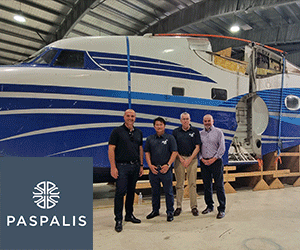1MG FlippingBooks
Innovation Through Adversity: Urban Water Reform
By Corinne Cheeseman
In the past 30 years, the Australian water sector has been through the most significant water reforms in our history, driven by the need to mitigate and adapt to a shifting climate and improve the efficiency and effectiveness of water management.

Water services are so essential to everyday life that it is easy to forget the effort required to supply high-quality drinking water at the turn of a tap and reliable wastewater services at the flush of a toilet. The key feature of water resources in Australia is the variability of rainfall and runoff, both around the country and over time. Large investments in water and wastewater assets valued at over $100 billion and the efforts of people, organisations and governments have been a feature of the development of the urban water sector since early European settlement and have helped to provide secure water services to our cities and towns in the context of such variability. They have also made Australia a leader in the development of reticulated wastewater systems and treatment technologies to protect public health, urban amenity and the environment.
Australia’s urban water systems evolved from the late 19th century, developing a strong engineering culture with a focus on technical performance. By the 1980s, prices were based mainly on the rateable value of properties served; cross-subsidies were rife; water businesses regulated their own prices and, in some cases, environmental performance; metering of consumption was not universal; and most capital works were undertaken by deploying day labour.
A consensus began to emerge in states and territories that this situation was not sustainable, and a process of reform began, driven partly by growing community concerns about environmental impacts and growing challenges involving capital investments. These problems, combined with broader recognition by governments and the community of the need to manage water resources efficiently and sustainably, drove the development and implementation of the first major coordinated national reform efforts.
In 1994, the Council of Australian Governments (COAG) water-reform agenda was part of a broader era of micro-economic reform known as the National Competition Policy (NCP) reforms. The NCP reforms aimed to harness competitive forces to increase efficiency and community welfare in response to concerns about Australia’s overall economic performance and productivity.
As a result, institutional separation of policy setting, service delivery and regulatory enforcement, in addition to pricing and market-oriented water resource allocation reforms, were achieved. Under the new model, governments were to articulate clear, measurable and coherent policy objectives and provide water-service providers with the autonomy and incentive to deliver. In return, service providers were to be transparent and accountable by clearly demonstrating performance to customers, government, regulators, shareholders and the community.
In recognition of continuing water-related challenges, particularly the Millennium Drought (2001–09), the National Water Initiative (2004) set out a more detailed and ambitious reform agenda aimed at optimising the economic, social and environmental outcomes associated with water in urban and rural areas. Implementation of those reforms has transformed the urban water sector.
The energy–water nexus
The Millennium Drought crisis spawned a significant surge in urban water infrastructure investment, which grew from a record $2.4bn in major cities alone in 2004–05 to more than $14bn in 2008 at the height of the drought.
An increase in energy use for urban water supplies was one problem. But when this increase in energy was added to a rise in electricity costs, the energy bill for urban water increased significantly. Ultimately, these costs were incorporated into water prices and passed on to consumers. In many places, it was no longer true to say that water is a small element of the cost of living compared with other utilities, such as gas and electricity.
To compound the challenge, Australia has a goal to reduce greenhouse gas (GHG) emissions to 80 per cent below 2000 levels by 2050 (Australian Government Department of Climate Change and Energy Efficiency, 2012). This meant that if the water sector was to contribute proportionately, then energy use for urban water would need to be reduced by more than 90 per cent from the projected 2030 levels. This drove a major focus on the water and energy sectors navigating the interrelated challenges of climate change, growing demand and resource security. Utilities have been actively exploring how to match renewable energy sources, from solar to biogas generation, to their various energy requirements.
Today, water utilities in Australia:
- generate about 20 per cent of their energy needs from their own renewable sources, made up of cogeneration, hydroelectricity and solar, with cogeneration accounting for approximately 15 per cent of energy production
- generate more than 60 per cent of their own electricity through co-digestion facilities at wastewater treatment plants
- produce about 9 per cent of electricity output in the National Electricity Market through hydroelectric plants
- fully offset desalination plants by renewable, wind and solar energy
- generate approximately 34MW of biogas electricity
- are developing capabilities in the hydrogen industry.
How this works in practice
SA Water is seeking to integrate renewable energy technologies across their operations. They are investing more than $300 million to install 154MW of solar photovoltaic generation at around 35 sites, along with 34MWh of energy storage devices, by the end of 2020.
Unitywater is using biosolids energy generation at existing sewage treatment plants, alongside smart energy-efficiency initiatives, to reduce reliance on fossil fuels, save $2.5 million in costs and keep customer bills as low as possible.
Yarra Valley Water’s ReWaste waste-to-energy facility in Wollert has been in operation for more than two years, producing enough energy each year to power up to 1,500 homes. The plant generates 90 per cent less greenhouse gas than using fossil fuels from the grid and saves 8,500 tonnes of carbon per year.
Jacobs has worked with Yarra Valley Water in Melbourne to map out a potential path forward for the role of wastewater treatment plants in accelerating the development of Australia’s hydrogen industry. “Sustainable hydrogen” – produced using recycled water and renewable energy sources – is one of the many avenues that may support Melbourne Water on their journey to decarbonisation.
Melbourne Water’s mini-hydro and methane gas systems, including nine mini-hydros across Melbourne’s water supply system, generate 61,000MWh of electricity each year – enough to power 9,000 households.
Indigenous engagement
Indigenous needs for water should be incorporated into water planning and management. Yet, for many decades, Indigenous water values were rarely addressed in water planning.
The history of water resource development – particularly the priority of chronological possession of land and water rights – has made it difficult for Indigenous people to retain customary connection and attain legal rights to water bodies in recent native-title processes. As a result, there have been significant barriers for Indigenous people to access water through allocations and thereby satisfy their water and related natural-resource management objectives.
The economic, social, amenity and environmental values of water planning and decision-making are widely understood, often seen in practice and well documented. However, cultural connection and Indigenous knowledge within these core values, either as a standalone value or subtly and intrinsically woven throughout, are typically poorly represented.
A lack of understanding about how Indigenous Australians value water has led to a lack of diversity and fairness in decision-making. Further, with Indigenous communities in northern Australia facing development of land and water resources that are culturally sacred, it is no longer acceptable to ignore the perspectives of Traditional Owners when it comes to water rights.
We have seen how the community has developed a deeper understanding of the connection to country. This is creating a heightened understanding of Indigenous cultural obligations to look after and interact with country in a sustainable way that validates our science.
There has been a greater understanding recently behind the needs and aspirations of Indigenous people, the engagement strategies employed to elicit Indigenous knowledge, assess Indigenous values and incorporate the results into the development of water plans and frameworks.
As a result, many state and territory governments have taken a stronger approach to engagement and are now developing water-policy instruments to better accommodate Indigenous people’s cultural, environmental and economic needs in water-management planning.
For example, in Victoria, the Department of Environment, Land, Water and Planning now has a fully dedicated and resourced Aboriginal water program and unit. In NSW, the Department of Planning, Industry and Environment has a dedicated Aboriginal Communities Water and Sewerage Program to improve water supply and sewerage services in eligible Aboriginal communities.
Properly valuing water, and reallocating it when necessary, is crucial to avoiding catastrophic costs and recovery after droughts, and to ensuring a sustainable water future for all Australians.
Looking forward
To continue to drive future innovation and reforms in the Australian urban water sector, strong leadership is required from government, the community and the water sector itself. Also needed is a diversity of supply and demand options for future water security, based on the best scientific research and community input.
Increased investment is also a must for adaptive planning in the face of further extreme climatic events. Building stronger partnerships with other sectors, such as urban planning, energy and transport, as well as between industry and government will enable more integrated water management and urban liveability outcomes.
Importantly, incorporating community input into water-governance arrangements and enhancing the level of communication with community representatives will provide the community with greater confidence in the sustainable management of water resources, as we all strive for a more sustainable water future.
Urban water and wastewater services underpin public health and wellbeing, contribute to social development and are a vital enabler of strong economic activity and growth across Australia. Sustainable management of urban water and wastewater systems helps protect the environmental health and biodiversity of water catchments, rivers and the marine environment, as well as the social and economic values that flow from the nation’s natural assets.
Corinne Cheeseman is the CEO of the Australian Water Association, Australia’s largest water network, which includes 700 corporate and 5000 individual members, across utilities, government agencies, engineering, urban design and planning, science, research, academia, energy, resources, manufacturing,










